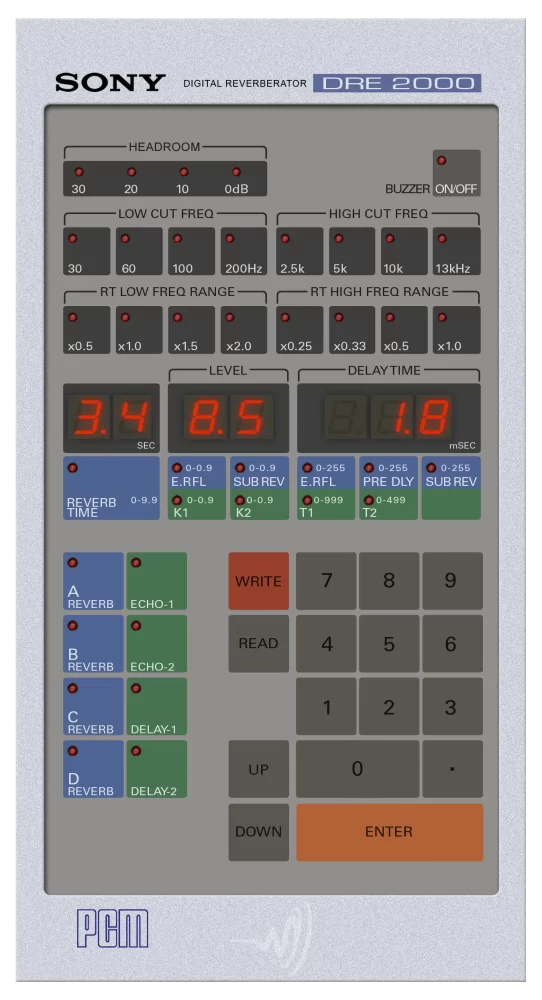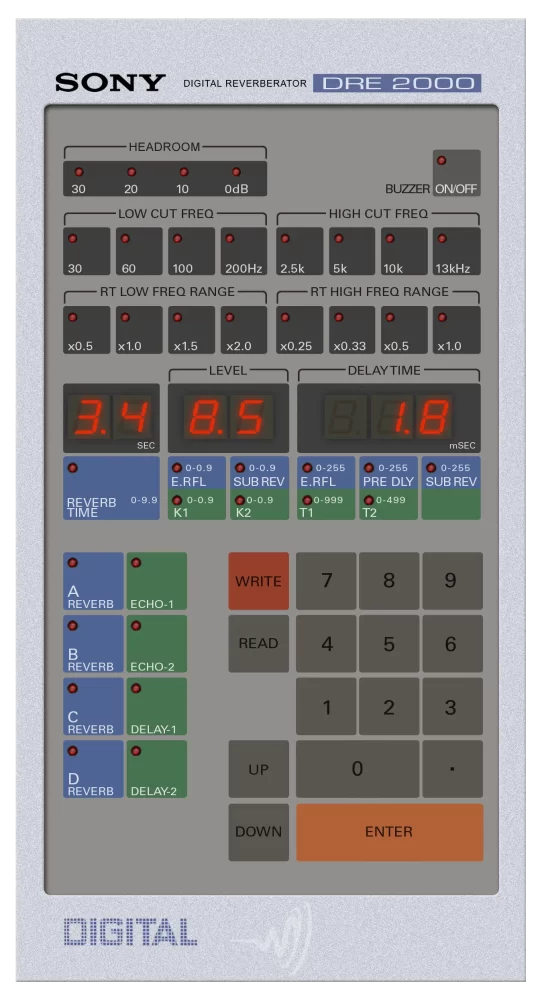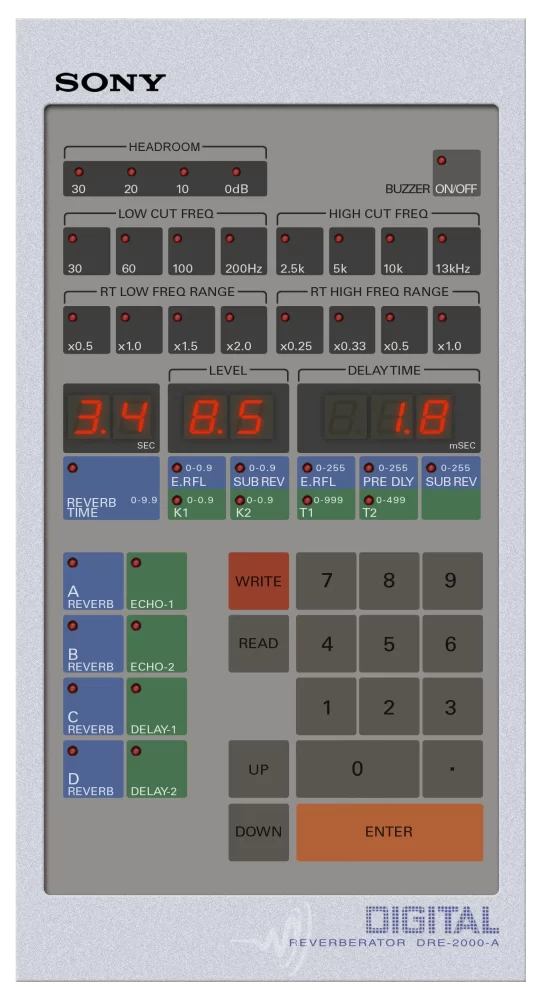The Sony DRE 2000, a legendary reverb unit, earned its reputation partly due to its association with Chris Lord-Alge, who has famously utilised it on countless mixes. Renowned for its physical presence and distinct sonic character, the Sony DRE 2000 remains a coveted piece of gear, despite its fragility and the difficulty of repairing the few remaining units. Fortunately, plugin recreations are helping preserve its legacy, ensuring its unique sound continues to influence modern productions.
Released in 1981 as Sony’s first digital reverb and the first from a Japanese manufacturer, the Sony DRE 2000 made its debut at the 67th AES Convention in New York in November 1980. Retailing at a significant $15,000 USD, it set a high standard for reverb technology. Its release predated similar products from Yamaha and Roland, with the Yamaha Rev1 appearing in 1983 and the Roland SRV-2000 following in 1984.
In 1982, Sony introduced Version 2 software for the DRE 2000, enhancing its stereo imaging, reverb depth, and decay smoothness while adding a second early reflection. The update included new reverb algorithms: Reverb-B (medium concert hall), Reverb-C (plate reverb), and Reverb-D (plate reverb with longer delays), alongside an improved Reverb-A (large concert hall). These updates significantly expanded the unit’s functionality and sound design possibilities.
The 1982 software update introduced crucial improvements, including wider stereo imaging, higher echo density, smoother decay, and a second early reflection for enhanced spatial realism. User feedback directly influenced these refinements, cementing the DRE 2000 as a forward-thinking product.
In 1984, the Sony DRE 2000-A was released, featuring Version 2 software pre-installed but omitting digital inputs and outputs, likely due to compatibility issues arising from its 32kHz sampling rate.
The New Programs
- Reverb-A
This program is basically the same as the old Reverb-B, but the stereo width is improved. Initial diffusion is not high but increases as sound decays. This program simulates a large concert hall. Early Reflection and Sub-Reverb parameters are unchanged. - Reverb-B
This program simulates a medium-sized concert hall. Initial diffusion is higher than Reverb-A. It has two early reflections but no Sub-Reverb. The level and the delay time of early reflection (Early Reflection-1) for channel-1 are controlled by the E.RFL level key and the E.RFL delay time key, respectively, while the level and the delay time of early reflection (Early Reflection-2) for channel-2 are controlled by the SUB REV level key and the SUB REV delay time key, respectively. The same controls apply to Reverb-C and Reverb-D. - Reverb-C
This program simulates a plate reverb whose initial diffusion is very high. This program is well suited for percussive sounds as well as many types of popular music. - Reverb-D
This program simulates a plate reverb like Reverb-C, but it comprises longer delay lines and has a lower initial diffusion than Reverb-C. This program has the least coloration of the four new programs. We recommend using it at a relatively long reverberation time of, say, over 4.0 sec.
The Sony DRE 2000’s hardware comprises a rack-mounted module housing the electronics and a remote-control unit for program selection and parameter adjustment. Its 3U height makes it slightly more compact than its competitor, the Lexicon 224, though its chassis is deeper.
The DRE 2000’s design features four circuit boards compared to the Lexicon’s eight and uses two fans for cooling. Over its production run, the unit and its remote control underwent three design iterations, adopting the iconic “DIGITAL” logo seen on other Sony professional products of the time.
Technologically, the Sony DRE 2000 offered remarkable advancements. It delivered high-quality reverberation effects with a superior signal-to-noise ratio, frequency response, and dynamic range. The unit’s electronic operation rendered it immune to external vibrations, allowing installation in varied environments.
Its programmable parameters and memory storage for up to 10 presets provided significant flexibility. Delay and echo modes added further versatility, with pre-programmed reverb, delay, and echo settings catering to a range of applications.
The Sony DRE 2000’s innovative features and exceptional sound quality made it a vital tool in professional studios of the era. Its distinctive reverb algorithms and adaptability contributed to its use on numerous iconic recordings, securing its place as a milestone in digital reverb technology.
Despite its limited availability today, the Sony DRE 2000’s influence endures, both through surviving units and modern digital recreations.
Primary Effects Features
- Reverberation
- Number of modes: 4 (REVERB A, B, C, D)
- Basic reverberation time (500 Hz – 1 kHz): 0 – 9.9 sec. (in 0.1 sec. steps), controllable in 100 steps
- Frequency response (multiplying factor with reference to basic reverberation time):
- Low Frequency Range (50 – 100 Hz): 0.5, 1.0, 1.5, 2.0
- High Frequency Range (5 – 8 kHz): 0.25, 0.33, 0.5, 1.0
- Pre-delay time: 0 – 255 millisec. (in 1 millisec. steps)
- Early reflection level: 0 – 0.9 (in 0.1 steps) (with reference to the level of main reverberation)
- Delay time: 0 – 255 millisec. (in 1 millisec. steps)
- Level of sub-reverberation: 0 – 0.9 (with reference to the level of main reverberation)
- Delay time between main reverberation and sub-reverberation: 0 – 255 millisec. (in 1 millisec. steps)
- Echo
- Number of modes: 2 (ECHO-1, ECHO-2)
- Decay factor: 0 – 0.9 (in 0.1 steps)
- Echo interval:
- ECHO-1: 0 – 999 millisec. (in 1 millisec. steps)
- ECHO-2: 0 – 999 millisec. (in 1 millisec. steps) and 0 – 499 millisec. (in 1 millisec. steps)
- Delay
- Number of modes: 2 (DELAY-1, DELAY-2)
- Delay time:
- DELAY-1: 0 – 999 millisec. (in 1 millisec. steps)
- DELAY-2: 0 – 999 millisec. (in 1 millisec. steps) and 0 – 499 millisec. (in 1 millisec. steps)




















